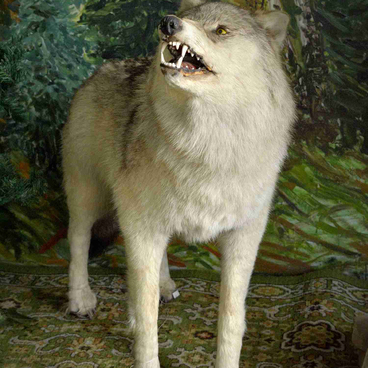The bearded owl is a large bird of the genus Strix. Its wing span can reach 1.5 meters, and it weights on average 900 grams. The species
can grow to up to 50 centimeters in length.
It is regarded as one of the most beautiful birds among those that live in Europe. Its plumage is very dense and fluffy. Bearded owls are grey with different shades interspersed throughout. Owing to their color, these birds can hide their presence really well by blending into their surroundings.
It got its name because of dark spots on the lower section of its beak. The bearded owl has a whitish collar or ‘bow tie’ around its neck, with a beard at the bottom. These birds have no ear tufts, a characteristic that distinguishes them from other birds in the owl family. Their beaks are positioned quite high and appear squeezed from each side.
These species are creatures of the night, i.e. they are awake and hunt when it is dark. When these owls move around their territory at night, they use their hearing to find their bearings. They can sense threats as well as hear their potential prey from a great distance.
These are very brave birds, which are prepared to fight the strongest of predators to protect their offspring and partners.
Their nests are usually located in hollows of forest trees, most often in glades not far from mossy swamps or under roofs of abandoned buildings. There is a good view of surroundings from such locations, hence it is easier for the birds to catch their prey. A distinguishing characteristic of bearded owls is how quiet they are - these birds very rarely call out to each other. They usually stay within their territory, and still these owls are capable of leaving their home and migrating to other regions for the winter.
If, in their opinion, a threat arises, these birds immediately compress the feathers against their bodies and become virtually invisible among the trees. They may then either attack or leave their hiding spots noiselessly.
Bearded owls visit dense forest thickets at night. They glide between trees silently, searching for various small rodents. These birds quite often attack their unsuspecting victims from their hiding spots. In Ancient Rus’, they were called insatiable creatures, in fact, their Russian name originates from this description.
It is regarded as one of the most beautiful birds among those that live in Europe. Its plumage is very dense and fluffy. Bearded owls are grey with different shades interspersed throughout. Owing to their color, these birds can hide their presence really well by blending into their surroundings.
It got its name because of dark spots on the lower section of its beak. The bearded owl has a whitish collar or ‘bow tie’ around its neck, with a beard at the bottom. These birds have no ear tufts, a characteristic that distinguishes them from other birds in the owl family. Their beaks are positioned quite high and appear squeezed from each side.
These species are creatures of the night, i.e. they are awake and hunt when it is dark. When these owls move around their territory at night, they use their hearing to find their bearings. They can sense threats as well as hear their potential prey from a great distance.
These are very brave birds, which are prepared to fight the strongest of predators to protect their offspring and partners.
Their nests are usually located in hollows of forest trees, most often in glades not far from mossy swamps or under roofs of abandoned buildings. There is a good view of surroundings from such locations, hence it is easier for the birds to catch their prey. A distinguishing characteristic of bearded owls is how quiet they are - these birds very rarely call out to each other. They usually stay within their territory, and still these owls are capable of leaving their home and migrating to other regions for the winter.
If, in their opinion, a threat arises, these birds immediately compress the feathers against their bodies and become virtually invisible among the trees. They may then either attack or leave their hiding spots noiselessly.
Bearded owls visit dense forest thickets at night. They glide between trees silently, searching for various small rodents. These birds quite often attack their unsuspecting victims from their hiding spots. In Ancient Rus’, they were called insatiable creatures, in fact, their Russian name originates from this description.



